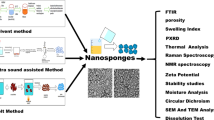Abstract
Itraconazole (ITZ) crystalline nanoparticles were prepared using relatively simple, low-cost sonoprecipitation technique, in which both the solvent and antisolvent were organic in nature. The effect of stabilizer type (hydroxypropyl methylcellulose, hydroxypropyl cellulose, Inutec SP1®, and pluronic F127), drying method (oven and freeze drying) and matrix former used (Avicel PH101, and Aerosil®200) on the dissolution performance as a key characteristic of nanocrystals was evaluated. In 10 min, all of the prepared nanocrystals showed 3.77−8.59 times improvement in percent drug dissolved compared to pure ITZ. Concerning the effect of stabilizer type, the following rank order can be given: pluronic F127 ≥ hydroxypropyl cellulose ≥ hydroxypropyl methylcellulose (HPMC) > inutec SP1. Freeze-dried ITZ nanocrystals containing Avicel PH 101 showed better dissolution rate compared to other nanocrystals. The chemical structure of itraconazole nanocrystals was not changed as revealed by Fourier transform infrared. Stability study of selected nanocrystals (F5, F7, and F8) revealed physical and chemical stability of F7 and F8, while a decrease in dissolution rate of F5 was observed (although being chemically stable) when stored under high relative humidity conditions. Although inutec is less potent than pluronic F127 and HPMC regarding their effect on dissolution rate enhancement, it is equipotent to pluronic F127 in preserving the rapid drug dissolution.










Similar content being viewed by others
REFERENCES
Fasano A. Innovative strategies for the oral delivery of drugs and peptides. Trends Biotechnol. 1998;4:152–7.
Lipinski CA. Poor aqueous solubility—an industry wide problem in drug discovery. Am Pharm Rev. 2002;5:82–5.
Rabinow BE. Nanosuspensions in drug delivery. Nat Rev Drug Discov. 2004;3(9):785–96.
Chen H, Khemtong C, Yang X, Chang X, Gao J. Nanonization strategies for poorly water-soluble drugs. Drug Discov Today. 2011;16(7–8):354–60.
Merisko-Liversidge E, Liversidge GG, Cooper ER. Nanosizing: a formulation approach for poorly-water-soluble compounds. Eur J Pharm Sci. 2003;18(2):113–20.
Chaubal MV, Popescu C. Conversion of nanosuspensions into dry powders by spray drying: a case study. Pharm Res. 2008;25(10):2302–8.
Buchanan CM, Buchanan NL, Edgar KJ, Klein S, Little JL, Ramsey MG, et al. Pharmacokinetics of itraconazole after intravenous and oral dosing of itraconazole–cyclodextrin formulations. J Pharm Sci. 2007;96(11):3100–16.
Yang W, Tam J, Miller DA, Zhou J, McConville JT, Johnston KP, et al. High bioavailability from nebulized itraconazole nanoparticle dispersions with biocompatible stabilizers. Int J Pharm. 2008;361:177–88.
Amidon GL, Lennernäs H, Shah VP, Crison JR. A theoretical basis for a biopharmaceutical drug classification: the correlation of in vitro drug product dissolution and in vivo bioavailability. Pharm Res. 1995;12:413–20.
Zhang JY, Shen ZG, Zhong J, Hu TT, Chen JF, Ma ZQ, et al. Preparation of amorphous cefuroxime axetil nanoparticles by controlled nanoprecipitation method without surfactants. Int J Pharm. 2006;323(1–2):153–60.
Dhumal RS, Biradar SV, Yamamura S, Paradkar AR, York P. Preparation of amorphous cefuroxime axetil nanoparticles by sonoprecipitation for enhancement of bioavailability. Eur J Pharm Biopharm. 2008;70(1):109–15.
Keck CM, Muller RH. Drug nanocrystals of poorly soluble drugs produced by high pressure homogenization. Eur J Pharm Biopharm. 2006;62:3–16.
Verreck G, Six K, Van den Mooter G, Baert L, Peeters J, Brewster ME. Characterization of solid dispersions of itraconazole and hydroxypropylmethylcellulose prepared by melt extrusion—part I. Int J Pharm. 2003;251(1–2):165–74.
Sinswat P, Gao X, Yacaman MJ, Williams 3rd RO, Johnston KP. Stabilizer choice for rapid dissolving high potency itraconazole particles formed by evaporative precipitation into aqueous solution. Int J Pharm. 2005;302(1–2):113–24.
Van Eerdenbrugh B, Froyen L, Van Humbeeck J, Martens JA, Augustijns P, Van Den Mooter G. Alternative matrix formers for nanosuspension solidification: dissolution performance and X-ray microanalysis as an evaluation tool for powder dispersion. Eur J Pharm Sci. 2008;35(4):344–53.
Wang B, Zhang W, Zhang W, Mujumdar AS, Huang L. Progress in drying technology for nanomaterials. Drying Technol. 2005;23:7–23.
Dong Y, Ng WK, Shen S, Kim S, Tan RB. Preparation and characterization of spironolactone nanoparticles by antisolvent precipitation. Int J Pharm. 2009;375(1–2):84–8.
Van Eerdenbrugh B, Vercruysse S, Martens JA, Vermant J, Froyen L, Van Humbeeck J, et al. Microcrystalline cellulose, a useful alternative for sucrose as a matrix former during freeze-drying of drug nanosuspensions—a case study with itraconazole. Eur J Pharm Biopharm. 2008;70(2):590–6.
Jackson CL, McKenna GB. The melting behavior of organic materials confined in porous solids. J Chem Phys. 1990;93(12):9002–11.
Lee J. Drug nano- and microparticles processed into solid dosage forms: physical properties. J Pharm Sci. 2003;92(10):2057–68.
Van Eerdenbrugh B, Froyen L, Van Humbeeck J, Martens JA, Augustijns P, Van den Mooter G. Drying of crystalline drug nanosuspensions—the importance of surface hydrophobicity on dissolution behavior upon redispersion. Eur J Pharm Sci. 2008;35(1–2):127–35.
Jacobs C, Kayser O, Müller RH. Nanosuspensions as a new approach for the formulation for the poorly soluble drug tarazepide. Int J Pharm. 2000;196(2):161–4.
ACKNOWLEDGMENT
The authors are grateful to Eva Pharma Company for conducting HPLC analysis.
Author information
Authors and Affiliations
Corresponding author
Rights and permissions
About this article
Cite this article
Badawi, A.A., El-Nabarawi, M.A., El-Setouhy, D.A. et al. Formulation and Stability Testing of Itraconazole Crystalline Nanoparticles. AAPS PharmSciTech 12, 811–820 (2011). https://doi.org/10.1208/s12249-011-9651-9
Received:
Accepted:
Published:
Issue Date:
DOI: https://doi.org/10.1208/s12249-011-9651-9




